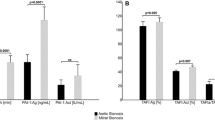Summary
While rheumatic valvular disease (RVD) is known to develop subsequent to rheumatic carditis, we examined whether in addition to the inflammatory and repair process, thromboplastic and fibrinolytic activities of the valvular tissue play a contributory role in the pathogenesis of RVD. Both activities were higher in resected valves from RVD cases than in the controls. Tissue thromboplastin was localized in the valvular endothelium and the subendothelial connective tissue. Tissue fibrinolytic activity was prevalent in the small blood vessels of RVD valves, while it was lower on the surface of RVD valves than in the controls.
High thromboplastic and low fibrinolytic activity in the surface layer of RVD valves may accelerate the deposition of thrombi, thereby inducing valvular thickening.
Similar content being viewed by others
References
Kaplan MH (1963) Immunological relation of streptococcal and tissue antigens. I. Properties of an antigen in certain strains of group A streptococci exhibiting an immunologic cross relation with human heart tissue. J Immunol 90:595
Zabriski JB, Freimer EH (1966) An immunological relationship between the group A streptococcus and mammalian muscle. J Exp Med 124:661
Vendsborg P, Hansen LF, Olessen KH (1968) Decreasing incidence of a history of acute rheumatic fever in chronic rheumatic heart disease. Cardiologia 53:332
Selzer A, Cohn KE (1972) Natural history of mitral stenosis: a review. Circulation 45:878
Magarey FR (1951) Pathogenesis of mitral stenosis. Br Med J 1:856
Astrup T (1965) Assay and content of tissue thromboplastin in different organs. Thromb Diath Haemorrh 14:401
Kwaan HC (1969) Dynamics of thrombus formation and dissolution, 1st ed. Lippincott Co, Philadelphia Toronto, p 114
Albrechtsen OK (1958) The fibrinolytic agents in saline extracts of human tissues. Scand J Clin Lab Inv 10:91
Todd AS (1958) Fibrinolysis autographs. Nature 181:495
Tweedy PS (1956) The pathogenesis of valvular thickening in rheumatic heart disease. Br Heart J 18:173
Dubin AA, March HW, Cohn K, Selzer A (1971) Longitudinal hemodynamic and clinical study of mitral stenosis. Circulation 44:381
Astrup T (1956) The biological significance of fibrinolysis. Lancet 2:565
Mustard JF, Jørgensen L, Packham MA (1970) Formed elements as a source of vascular injury. Thromb Diath Haemorrh (Suppl) 40:137
Walton KW, Williamson N, Johnson AG (1970) The pathogenesis of atherosclerosis of the mitral and aortic valves. J Pathol 101:205
Rodbard S, Johnson AG (1962) Disposition of flow-borne materials on vessel walls. Circulation Res 11:664
Author information
Authors and Affiliations
Rights and permissions
About this article
Cite this article
Homma, T., Okudaira, S. & Iida, Y. Studies on thromboplastic and fibrinolytic activities of valvular tissue in rheumatic valvular disease. Res. Exp. Med. 176, 193–200 (1980). https://doi.org/10.1007/BF01855839
Received:
Accepted:
Issue Date:
DOI: https://doi.org/10.1007/BF01855839




